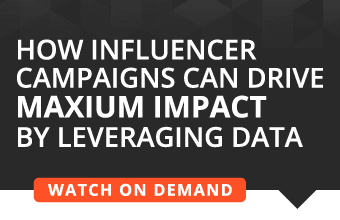Individuals spend an average of 11 hours on some form of media within a given day—with almost an hour being dedicated solely to social networking, as cited by Nielsen in 2018. As users scroll through their endless newsfeeds, they are met with bright images of aspirational travels, adventures and highly-curated realities. In this technology-dependent era lies the distinct and undeniable power of social media influencers.
A social media influencer is a broad term used to identify and differentiate individuals with strong social followings among various platforms. Known for their authentic and engaging online presence, influencers have been deemed a successful way to connect a brand with a specific target audience. These partnerships allow brands to utilize influencers to reach new and untapped markets. However, it is critical to understand that not all partnerships are built the same.
Establishing engagement-based partnerships
Partnerships are often times being created based on an influencers’ following regardless of their engagement. Brands looking to hone in on the benefit of influencers need to look past the simplistic metric of follower count and focus on the actual relationship between influencers and their direct following. Destinations have to think, “are these followers going to engage with the brand, and are they truly going to make travel plans?” Looking at an influencer’s comment section on a given post can provide an in-depth insight into their relationship with their followers. Those who create a platform that invites a two-way conversation tend to have a relationship with their followers that is primarily based on trust and transparency.
“Pay attention to engagement and quality of content rather than following size,” said Chelsea from @ChelseaAsOfLate.
Numbers are deceptive. An individual can be perceived to have a significant following but the majority of their followers can be internet bots that were paid to comment and follow social media pages. It takes time and experience, and a little software help, to be able to evaluate an influencer. Using software systems like Heepsy and Amasome can help alleviate the process of searching through thousands of influencers and can provide the engagement-to-follower ratio as well as their niche focus. Using a platform is a great way to start. However, it is important to follow potential influencers to evaluate their day-to-day interactions to understand their true value and potential. It’s easy to rush, but strong influencer campaigns take time.
Trusting creative freedom
It all starts with having a clear and attainable goal. Before reaching out to an influencer, a brand has to be able to provide envisioned expectations and guidelines. Communication is key. Clear contracts that state the details featuring the number of posts and image rights will help avoid the grey areas that currently plague influencer marketing. By clearly discussing communication goals surrounding exact deliverables, both parties will have a clear idea of not only expectations but how to work in a cohesive manner to the target the desired audience.
“When brands want to manage every single bit of copy that you create, it can take away the authenticity that your audience engages with best,” said Jules and Christine from @DontForget2Move.
To achieve ultimate authenticity, the brand should trust the partner they hired to help represent their brand without having to micromanage.
By articulating these expectations upfront, influencers can explore their talents while vocalizing the realities of their work to partnering brands. The trust an influencer earns through years of hard work can be broken down by a single post. Campaign efforts should organically blend without disrupting the of the influencer ’s relationship with their audience. Having a sense of mutual respect allows the partnership to grow into an authentic campaign.
Consistent messaging
Successful marketing campaigns result in an increase in awareness and consumer recognition for the brand. Ideally, travel destinations want to know that their target audience was impacted by the influencer. Tangible measurements that influencers tend to prioritize revolve around the broad term “engagement,” which includes likes, comments and shares of a given social post. Brands have the option to utilize other performance tracking systems like the Urchin Tracking Module or UTM. UTM establishes a direct link between influencer generated traffic and conversions. It is up to the brand to decide and highlight those crucial data touch points that will be successful in increasing conversion rates.
“The best part of working with a brand is seeing the impact my campaigns have for them, and being able to see just how many people book a trip, buy a product, or visit a destination because of my blog and Instagram content,” said Christina from @JetSetChristina.
Brands should try to create year-long partnerships with influencers for a more continuous, and repetitive message over a longer period of time. A single post is not nearly as effective as a quarterly trip highlighting different components of the travel destination. Taking advantage of these long-term partnerships can be cost-effective and can be a destination’s secret weapon for announcements and large events coming down the pipeline.
“Smart brands will find allies and partners that they want to do a long term deal with… The messaging becomes more effective to the audience because it’s repetitive and consistent as opposed to someone who never mentions [the destination] again,” said Lindsay from @LindsaySilb.
Effective influencer marketing is simple and should be an extension of already existing marketing strategies. Marketing teams should partner with influencers that they are familiar with and have already been following. That way, marketing teams can be confident that they have chosen a social media personality who can personalize the destination with content that complements the brand. Ultimately, influencers are able to provide an online community that mimics the most powerful form of marketing—word-of-mouth, while also putting a face to the destination. With thousands upon thousands of brands fighting for consumers’ attention, a destination needs to find a way to stand out.
For more information on influencer marketing, check out “Connections: Travel Influencers & Destination Marketing,” a study conducted by The Abbi Agency, a fully-integrated marketing firm at the forefront of the travel industry.








